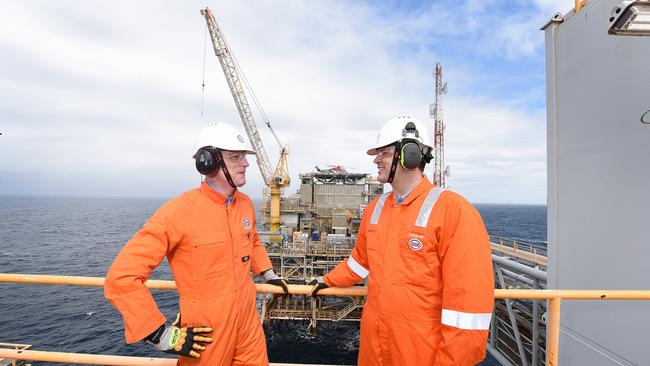Let’s tell it Strait: Life’s a gas on these fields of blue
Craig MacGregor spends half his life on a steel island harvesting gas from deep below the blue waters of the Bass Strait.

Craig MacGregor might spend half his life on a steel island harvesting gas from deep below the blue waters of the Bass Strait, but to him it’s as normal as an office job in Victoria’s capital.
Every two weeks the offshore installation manager farewells his wife and two children in the Gippsland city of Sale, which is 215km east of Melbourne, and takes a 10-minute helicopter ride to the Marlin gas platform, where he will spend the next 14 days.
He said when he started working on offshore he was struck by the vastness of the water but after almost two decades he had become accustomed to life on an oil rig 20km offshore.
“People will look at waves, sunsets and sunrises and you do see some pretty spectacular scenery, but at the end of the day your job is your role,” he said.
“The vastness of being in the middle of the ocean, I guess, washes over you after a while.” Mr MacGregor is one of the lucky few to have private quarters, with the bulk of the Marlin’s workers in shared quarters, although round-the-clock shifts mean only half are resting at any time.
When The Weekend Australian visited the Marlin platform, workers in high visibility suits on a break were collecting fish and chips from a chef in the mess hall.
Outside on the lower deck, there were five well-worn fishing rods and a cleaning bench was attached to the railing.
Below, fur seals laze and flap about on steel rods as they wait for kitchen scraps to be dumped. ExxonMobil and BHP jointly own the 14 fields, which are all named after fish, with the legacy fields Marlin, Snapper and Barracouta in decline — essentially running low on gas — prompting fears of future supply shortfalls and price hikes for Australia’s east coast.
Drilling on the new West Barracouta field is on track to deliver relief to the squeezed market, which receives 40 per cent of its gas supply from the Bass Strait, but the Australian Energy Market Regulator has forecast rapid decline for the gas fields.
It estimates proven and probable gas reserves will still fall by more than 50 per cent by the end of 2023.
ExxonMobil late last year flagged the sale of its 50 per cent stake in the project. ExxonMobil Australia chairman Nathan Fay said this was part of a periodic review of the US gas and oil giant’s global assets.
“We’re really just going out there and exploring if there’s somebody out there who potentially it’s a stronger strategic fit for,” he said.
Speaking to The Weekend Australian in an office on the Marlin platform, Mr Fay said until a deal had been signed, business would continue as usual with huge quantities of untapped gas still waiting below the surface of Bass Strait.
“There’s a number of deeper reservoirs that we can get after from some of our existing platforms so we’re drilling down deeper … and we’ll be moving and do some plug and abandonment work,” he said.
It is understood concerns over clean-up costs of any future closure of the gas fields, which include 14 stations, have delayed any sale until later this year.
Remediation is estimated to cost between $5bn and $7bn.
The Weekend Australian visited the Gippsland Basin Joint Venture as a guest of ExxonMobil and APPEA.

